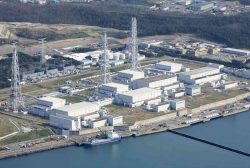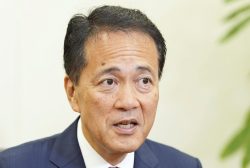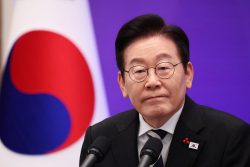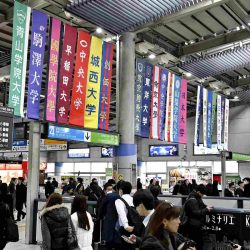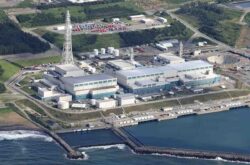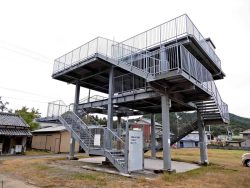TEPCO raises flounder in Fukushima No. 1 nuclear power plant’s ‘treated water’ to underline ‘safety’
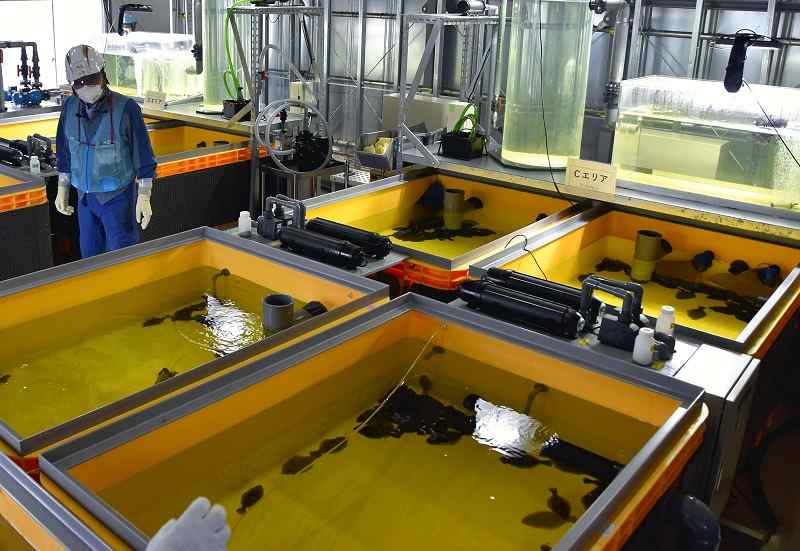
Flounder are seen raised in tanks using treated water at the Fukushima No.1 nuclear power plant in Fukushima Prefecture on Monday.
18:10 JST, October 18, 2022
FUKUSHIMA — Tokyo Electric Power Company Holdings, Inc. is raising flounder in so-called treated water containing radioactive materials from the Fukushima No. 1 nuclear power plant crippled by the March 11, 2011, earthquake and tsunami.
By showing how the flounder have no abnormalities compared to those raised in seawater, TEPCO aims to demonstrate the safety of treated water ahead of the planned release of that water into the sea next spring.
The central government is also stepping up its efforts to disseminate to relevant industries and consumers information related to the safety of the treated water.
After the nuclear accident, the water used to cool the reactor was contaminated with radioactive materials at the facility. The treatment process has removed most of the radioactive materials, except tritium.
The tritium concentration in the flounder tanks is at the same level as the water to be discharged into the sea, which is less than 1/40th of the national standard for discharging such material. When TEPCO discharges the treated water, it will be further diluted with seawater. There are about 1.3 million tons of treated water, and tanks to store it are expected to be full by autumn 2023.
Diluted tritium is said to be safe to handle and is discharged into the sea at nuclear power plants around the world.
TEPCO invited the media to the facility Monday. A warehouse on the grounds of the nuclear power plant was turned into the aquaculture facility with 22 tanks to raise flounder. Blue tanks were filled with sea water while yellow tanks had treated water. There were about 730 young flounder in the tanks. The tanks are monitored around-the-clock with five screens displaying data such as water temperature and oxygen levels.
The power company plans to announce as necessary whether the flounder develop abnormalities and information such as the tritium concentration in the fish. It also plans to add abalone and seaweed into the tanks.
“Seeing living things growing properly in treated water should lead to a sense of confidence,” a person in charge of the project said.
The central government is also focusing on awareness-raising activities for industries and consumers. In late September, the Economy, Trade and Industry Ministry invited 14 members of the National Supermarkets Association of Japan to the Fukushima No.1 nuclear power plant to observe the process of removing radioactive materials from the water.
“We were able to gain understanding by actually seeing the process,” said the association’s Secretary General Yasuhiro Shimahara. “We would like to cooperate, as it is necessary to also use social media to reach out to consumers.”
To achieve transparency, the central government is employing additional measures, such as monitoring of seawater, having the International Atomic Energy Agency provide safety assessments and providing information to influencers who can effectively disseminate it.
In 2015, TEPCO promised the Fukushima Prefectural Federation of Fisheries Cooperative Associations and others opposed to the discharge of treated water that it will not do so without the understanding of all relevant parties.
The ministry has set up a ¥30 billion fund to buy up marine products if rumors related to the discharge harm sales. It is also considering establishing a separate fund.
“Thorough data collection is needed by diversifying the kinds of fish raised at the facility and other conditions,” said Toru Takahashi, the 67-year-old chairman of the prefectural trawl fisheries cooperative federation. “There is a lot that needs to be done.”
"Business" POPULAR ARTICLE
-

Tokyo Economic Security Forum to Hold Inaugural Meeting Amid Tense Global Environment
-

Keidanren Chairman Yoshinobu Tsutsui Visits Kashiwazaki-Kariwa Nuclear Power Plant; Inspects New Emergency Safety System
-

Imports of Rare Earths from China Facing Delays, May Be Caused by Deterioration of Japan-China Relations
-

University of Tokyo Professor Discusses Japanese Economic Security in Interview Ahead of Forum
-

Japan Pulls out of Vietnam Nuclear Project, Complicating Hanoi’s Power Plans
JN ACCESS RANKING
-

Tokyo Economic Security Forum to Hold Inaugural Meeting Amid Tense Global Environment
-

Keidanren Chairman Yoshinobu Tsutsui Visits Kashiwazaki-Kariwa Nuclear Power Plant; Inspects New Emergency Safety System
-

Imports of Rare Earths from China Facing Delays, May Be Caused by Deterioration of Japan-China Relations
-

University of Tokyo Professor Discusses Japanese Economic Security in Interview Ahead of Forum
-

Japan Pulls out of Vietnam Nuclear Project, Complicating Hanoi’s Power Plans



